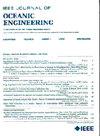模糊灰色认知地图在海上载人与自主避碰中的应用研究
IF 5.3
2区 工程技术
Q1 ENGINEERING, CIVIL
引用次数: 0
摘要
随着海上自主水面舰艇(MASS)缓慢但稳定地接近全面实施,其安全性问题仍然存在。尽管这是一项颠覆性的技术,但它们很可能会像现在的载人飞船一样,受到影响其安全性能的相同因素的影响。然而,这些因素的影响在每种情况下可能是不同的。本研究将模糊灰色认知图(FGCMs)应用于海上避碰影响因素的比较评估。为此目的,已征求了有关问题的专家,并对他们提供的数据进行了分析,以了解特定因素强度的变化将如何影响安全性能。所获得的结果表明,使用FGCM,可以对海上避碰过程的特定阶段以及整个过程中选定因素的相对影响进行建模。所进行的分析表明,某些因素的影响存在明显的可变性,这取决于它们在过程中激活的时间(时间依赖性),并且使用FGCM可以评估其量化。此外,结果表明,与载人和自主船舶相比,因素对遭遇阶段的影响差异更大。这项研究的结果可能会对参与海上安全建模的所有各方以及即将推出的自主船舶的工作产生兴趣。本文章由计算机程序翻译,如有差异,请以英文原文为准。
Toward Using Fuzzy Grey Cognitive Maps in Manned and Autonomous Collision Avoidance at Sea
With Maritime Autonomous Surface Ships (MASS) slowly but steadily nearing full-scale implementation, the question of their safety persists. Regardless of being a disruptive technology, they will likely be subject to the same factors shaping their safety performance as manned ships nowadays are. Yet, the impact of these factors may be different in each case. The current study presents an application of Fuzzy Grey Cognitive Maps (FGCMs) to the comparative evaluation of factors affecting collision avoidance at sea. To this end, subject matter experts have been elicited, and the data obtained from them have been analyzed, concerning how changes in the intensity of given factors would affect safety performance. The obtained results showed that with the use of FGCM, it was possible to model the relative impact of selected factors both on a specific phase of the maritime collision avoidance process as well as on its entirety. The conducted analysis shows noticeable variability of the influence of some factors, depending on the timing of their activation during the process (time dependence), and using FGCM, it was possible to assess its quantification. Furthermore, the results indicate that greater differences can be found between the factors’ impact on phases of an encounter than between manned and autonomous ships. The outcome of this study may be found interesting for all parties involved in maritime safety modeling as well as working on the forthcoming introduction of autonomous ships.
求助全文
通过发布文献求助,成功后即可免费获取论文全文。
去求助
来源期刊

IEEE Journal of Oceanic Engineering
工程技术-工程:大洋
CiteScore
9.60
自引率
12.20%
发文量
86
审稿时长
12 months
期刊介绍:
The IEEE Journal of Oceanic Engineering (ISSN 0364-9059) is the online-only quarterly publication of the IEEE Oceanic Engineering Society (IEEE OES). The scope of the Journal is the field of interest of the IEEE OES, which encompasses all aspects of science, engineering, and technology that address research, development, and operations pertaining to all bodies of water. This includes the creation of new capabilities and technologies from concept design through prototypes, testing, and operational systems to sense, explore, understand, develop, use, and responsibly manage natural resources.
 求助内容:
求助内容: 应助结果提醒方式:
应助结果提醒方式:


